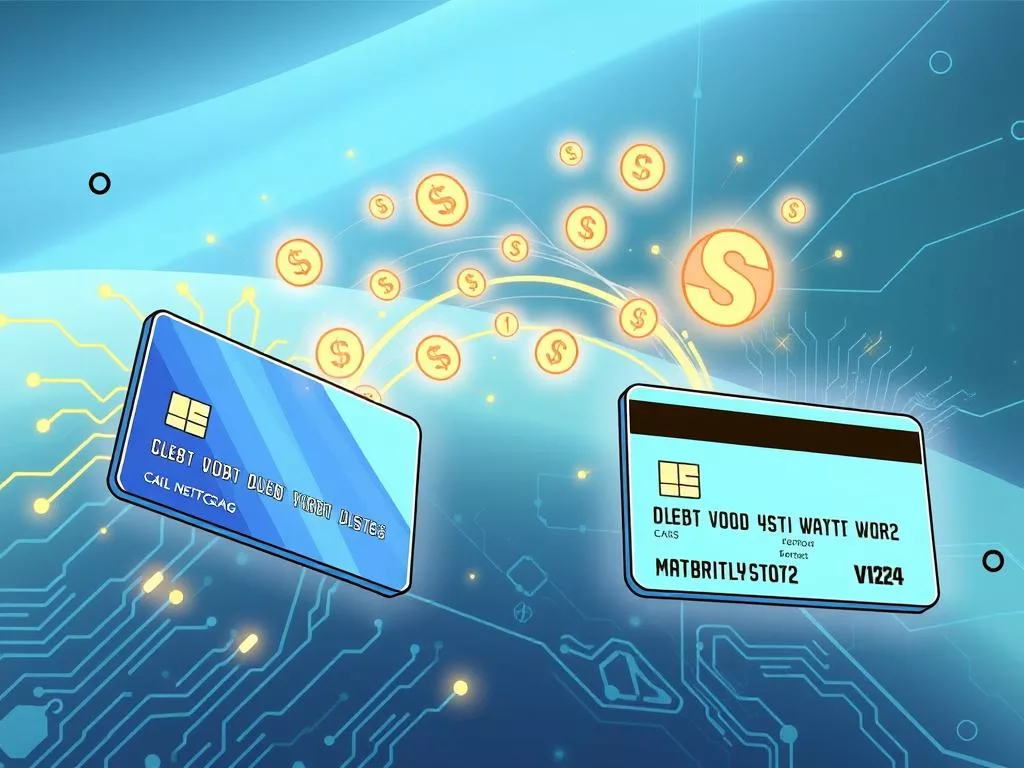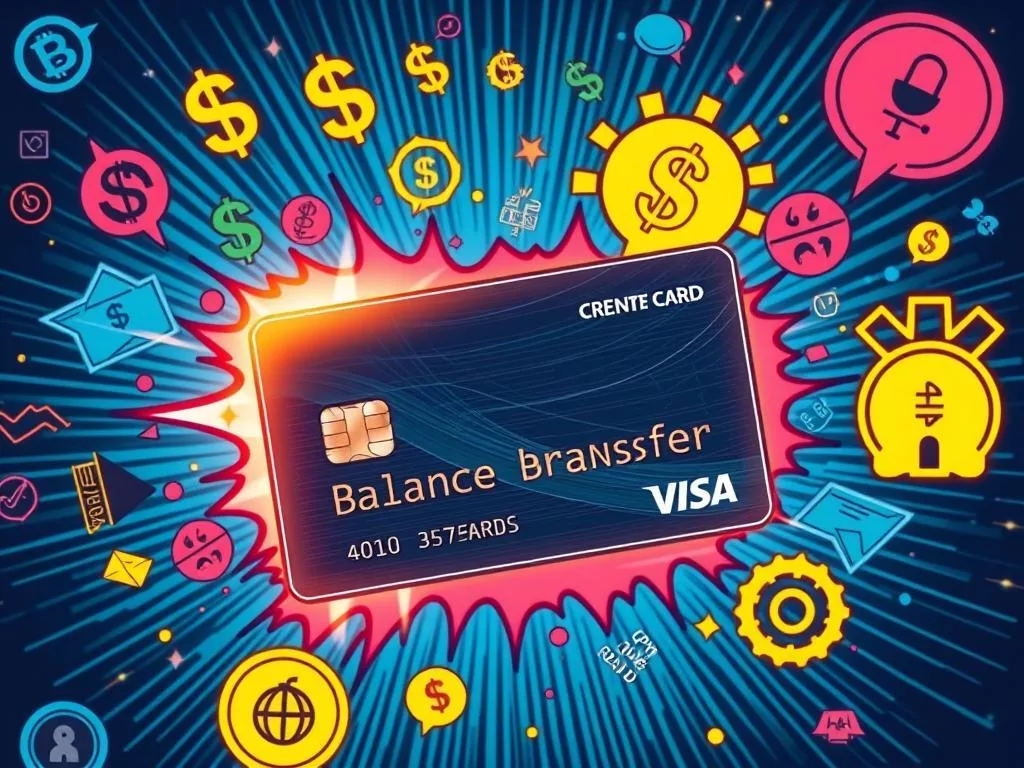The balance transfer process is a great way to lower your credit card debt. It lets you move your balances to new cards with zero percent APR offers. This can save you money on interest and help you pay off your debt faster. In this guide, we’ll cover everything you need to know about balance transfers. We’ll compare the best balance transfer cards and give you tips for making smart choices.
Choosing the right balance transfer card is key. For example, the Citi Simplicity® Card has a 0% intro APR on balance transfers for 21 months. After that, it has a variable APR of 18.49% – 29.24%. There’s a 3% balance transfer fee for the first period.
The Wells Fargo Reflect® Card also offers a 0% APR on balance transfers for 21 months. It has a 5% fee, which can save you a lot on interest. The Discover it® Chrome card has an 18-month 0% introductory period on balance transfers. It charges a 3% fee initially and up to 5% for later transfers.
When picking a balance transfer card, look at both the promotional APR periods and fees. The U.S. Bank Visa® Platinum Card and the Citi® Diamond Preferred® Card are good options. The former offers an 18 billing cycle 0% APR, and the latter has 21 months of the same benefit.
Our guide to transfer credit card balances provides a detailed comparison of these cards. It helps you understand the balance transfer process better. This way, you can make informed decisions to reduce your credit card debt efficiently.
Understanding Balance Transfers and Their Benefits
Balance transfers can save you a lot of money, mainly when you have high-interest credit card debt. A key part of these transfers is the chance to lower your credit card APR. Balance transfer cards usually offer an interest-free period of six to 18 months. This lets you pay off your debt more easily.
But, transferring balances often comes with a fee, usually 3% to 5% of the amount moved. Even with this fee, the benefits of lower interest rates and financial relief often make it worth it.
Balance transfers offer more than just lower interest rates. Moving your debt to a card with a 0% introductory APR can greatly reduce the total interest you pay. Plus, it can improve your credit score by lowering your credit utilization ratio. But, be careful when the promotional period ends. If you don’t pay off the balance, you could face a high penalty rate, up to 29.99%.
Another big plus of balance transfers is the chance to combine debts from several high-interest cards into one. This makes managing your debt easier and often lowers your monthly payments. When picking a balance transfer card, look at options like the BankAmericard® credit card and the Wells Fargo Reflect® Card. They offer longer promotional periods to help you save more money.
It’s also important to remember that transfer fees can affect your new card’s credit limit. And, applying for a new card can lower your credit score due to a hard inquiry. To get the most out of balance transfers, make sure to pay on time and understand the terms of your card.
Step-by-Step Guide to Transfer Money from One Card to Another
Transferring balances can make managing debt easier. Here’s a detailed guide on how to do it:
- Assess Your Current Debts: Start by looking at all your credit card debts. Pick which ones you want to transfer. Add up the total amount you plan to move.
- Choose the Right Card: Find a balance transfer card with a low or 0% intro APR. For example, the Wells Fargo Reflect® Card has a 0% intro APR for up to 21 months. Make sure the new card has enough credit limit for the transfer.
- Understand the Fees: Know the balance transfer fees, which are 3% to 5% of the amount moved. Check these fees to see if the transfer is worth it.
- Application Process: Apply for the chosen card. After approval, you have up to 60 days to transfer to get promotional rates.
- Initiate the Transfer: You can transfer online, by phone, or with balance transfer checks. Start the transfer quickly to avoid interest on your old card.
- Monitor Transfer Time: Transfer times differ. American Express takes 5-7 days, while Discover does it in 4 days. Most take 2 to 21 days.
- Verify Completion: After the transfer, check if all balances moved to the new card. Contact both issuers if you find any errors.
- Manage New Card Payments: Pay off your new card balance before the promo ends, usually in 6 to 21 months. This avoids high interest rates.
- Consider Closing Old Cards: Keeping old cards open helps your credit history. But closing them can hurt your score.

Knowing these credit card transfer steps can save you money and improve your finances. It’s key to understand how to transfer credit card balances and pick the best card for your needs.
Choosing the Right Balance Transfer Card
Choosing the right balance transfer card is key to getting the most out of a balance transfer. Look for a card with a long zero-interest period, low fees, and a high credit limit. The best card usually offers up to 21 months of zero-interest, helping you pay off debt without extra interest.
When picking a card, also check the fees for transferring balances. These fees are usually 3 percent to 5 percent of the balance, with a $5 minimum. For example, moving a $1,000 balance might cost $30 to $50. It’s also important to know that these cards often require very good or excellent credit, starting at a FICO score of 740.
Looking at the full criteria of balance transfer cards and comparing them is smart. Cards like the Citi Simplicity® Card and the Wells Fargo Reflect® Card are top picks. They offer long zero-interest periods and no late fees, fitting different debt needs.

Also, think about the regular APR after the intro period, rewards, and perks. Guides on optimal transfers suggest choosing a card that fits your financial situation. While higher credit limits and rewards are valuable, they should not overshadow the goal of paying off debt.
| Card | Zero-Interest Period | Transfer Fee | Regular APR | Credit Score Requirement |
|---|---|---|---|---|
| Citi Simplicity® Card | 21 months | 5% | 14.99% – 24.99% | Very Good – Excellent (740+) |
| Wells Fargo Reflect® Card | 18 months | 3% | 12.99% – 24.49% | Very Good – Excellent (740+) |
In conclusion, by carefully choosing a balance transfer card, you can manage and reduce your debt effectively. Look at the zero-interest period, fees, and credit requirements. This way, you ensure the card meets both your short-term and long-term financial goals.
Important Considerations Before Transferring Funds
Before you transfer your balance, it’s important to plan carefully. Start by looking at your financial situation. This will help you understand how the transfer will affect your money and credit score. Also, think about the fees for different transfer options, like the $26 fee for domestic wire transfers, as reported in a November 2023 Bankrate survey.
Next, check the details of balance transfer cards. Look at interest rates, fees, and how long the low APR lasts. Some banks might limit transactions, even if you can withdraw more from savings. Services like Zelle and Venmo are free and fast, but they have limits on how much you can send.
Creating a smart balance transfer plan means knowing how to use your new credit wisely. Make a plan to pay off the balance before the low rate ends. Consider the different ways to transfer money, like wire transfers, ACH, and P2P services. Each has its own costs, speed, and safety features. For example, ACH is cheap for regular transfers, but wire transfers are quicker but pricier.
With so many options, from banks to money transfer services, it’s important to stay informed. Services like Xe offer good rates and low fees for big transfers. Doing a test transfer can help you get used to the process and feel less stressed. For more tips on transferring money, check out this guide on transferring money from abroad.

